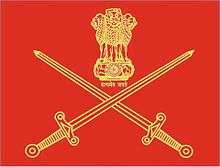IV Corps (India)
| IV Corps | |
|---|---|
| Active | 1961-Present |
| Country | India |
| Branch | Indian Army |
| Type | Army Corps |
| Size | Corps |
| Part of | Army Eastern Command |
| Garrison/HQ | Tezpur |
| Commanders | |
| Current commander | Lt Gen Devraj Anbu |
| Notable commanders |
Field Marshal Sam Manekshaw General Om Prakash Malhotra General Nirmal Chander Vij Lt Gen Sagat Singh Lt Gen Harbaksh Singh |
The IV Corps is a military field formation of the Indian Army, created in 1961.[1]
The IV Corps in the India Pakistan War 1971
| Indian Army Corps (1947 - Present) | |
|---|---|
| Previous | Next |
| III Corps | IX Corps |
"Under the command of Lieutenant General Sagat Singh the IV Corps, with all eight East Bengal Regiment battalions, had already made some gains before the war.[2] An enclave south of Akaura served as a springboard for 57 Division, which advanced along the rail line to Ashuganj.[3] In seesaw fighting that saw several successful Pakistani counterattacks, 27 Brigade of the Pakistani 14th Infantry Division fell back across the Meghna River and destroyed part of the rail bridge, blocking immediate passage of the river. General Singh, however, saw Dacca as “the final answer” and decided “to go beyond my assigned task.”62 In an impressive display of improvisation, IV Corps began crossing the broad Meghna on 9 December in a hastily assembled helicopter lift operation supplemented by every variety of local water craft. Pakistan’s 14 Division was no longer a hindrance as its 27 Brigade had retired to Bhairab Bazar and its other two brigades (202 and 313) were isolated at Sylhet."
"Further south, the Indian 23rd Infantry Division also reached the Meghna on 9 December, seizing both Daudkandi and Chandpur against light resistance. The isolated Pakistani force at Laksham capitulated the same day, leaving only the garrison of Mayanmati to offer organized resistance east of the Meghna. The Pakistani 39 Division had disintegrated.65 A sense of imminent victory drove the Indians, and, as 57th Mountain Division painfully built up its strength west of the river, 23 Division (shedding 83 Brigade and “Kilo Force” to push toward Chittagong), prepared to make its own improvised crossing. In another colorful, tenuous helicopter and boat operation, 301 Brigade landed at Baidya Bazar on 14 December and closed on the Lakhya the following day."
"India’s 57 Division was also advancing: 311 Brigade and “Sierra Force” were threatening Demra and 73 Brigade had reached the Balu east of Tungi. General Sagat Singh’s decision to “go beyond his assigned task” had paid off. The Indians were also approaching Dacca from the northwest, hindered more by severe logistics constraints than by the near-nonexistent Pakistani opposition. Indeed, Pakistani 93 Brigade, over the protest of its commander, had been withdrawn toward Dacca in a desperate attempt to shield the unprotected capital against the Indian troops advancing rapidly from the east and northeast. The Indian airborne drop of 2 Para at Tangail on 11 December accentuated the menace to Dacca. Although 2 Para’s appearance made only a marginal contribution to the tactical battle, it helped to unnerve Niazi and others in Eastern Command headquarters, already anxious because of the lack of regular combat troops in the capital.68 Predations of the local Mukti Bahini under Qadir “Tiger” Siddiqi compounded Pakistan’s woes, disrupting movements and depleting morale. The Indian paratroopers joined hands with 95 Brigade on 12 December and, with 167 Brigade hastening up from Jamalpur, soon reached and crossed the Turag."
"By 15 December, the Pakistani situation around Dacca was hopeless: the lone brigade of 36 Division was broken, the newly arrived 314 Brigade was little more than a paper organization, 14 Division was sitting demoralized and useless at Bhairab Bazar, and 39 Division had ceased to exist. On the morning of 16 December, Major General Mohammed Jamshed Khan drove out of Dacca to arrange the cease-fire."
Composition
In 1961, IV Corps, which had been disbanded within the British Indian Army after the Second World War, was reestablished. It currently consists of:
- 71 Mountain Division headquartered at Missamari
- 5th Mountain Division (Ball of Fire) headquartered at Bomdila. The division was converted to a mountain division in 1963. It is posted to the west of 2 Mountain Division in Arunachal Pradesh.[4]
- 21st Mountain Division headquartered at Rangia. The 'Red Horn' Division includes 77 Mountain Brigade,[5] and, as of January 2010, 315 Field Regiment (India) of the Regiment of Artillery, based at Udalguri.[6]
In addition, as of mid-2010, an additional mountain division appears to be forming, reportedly to be attached to this corps, located in Assam.[7] It has been confirmed as being 71 Mountain Division.
Notes
- ↑ Orbat.com, Indian Army Corps 2003, accessed July 2010
- ↑ John H. Gill, An Atlas of the 1971 India - Pakistan War: The Creation of Bangladesh, Near East South Asia Centre for Strategic Studies (National Defense University), p.28-29
- ↑ The Indian infiltration began on the night of 1/2 December. See Maj. Gen. Ashok Kalyan Verma’s vivid and thoughtful account in Rivers of Silence (New Delhi: Lancer, 1998), 87-178. (Gill, An Atlas of the 1971 India - Pakistan War, NESA Centre/NDU, p.28 and p.95)
- ↑ Conboy et al, Elite Forces of India and Pakistan,p.8
- ↑ http://www.accessmylibrary.com/coms2/summary_0286-34700130_ITM
- ↑ Blood thickens bond among people, The Telegraph (Kolkata), Calcutta, January 9, 2010
- ↑ http://chhindits.blogspot.com/2010/07/dna-page-1-indian-armys-new-division-to.html
References
- John H. Gill, An Atlas of the 1971 India - Pakistan War: The Creation of Bangladesh, Near East South Asia Centre for Strategic Studies (National Defense University), via scribd.com
External links
- Globalsecurity.org, Eastern Command, accessed July 2010
